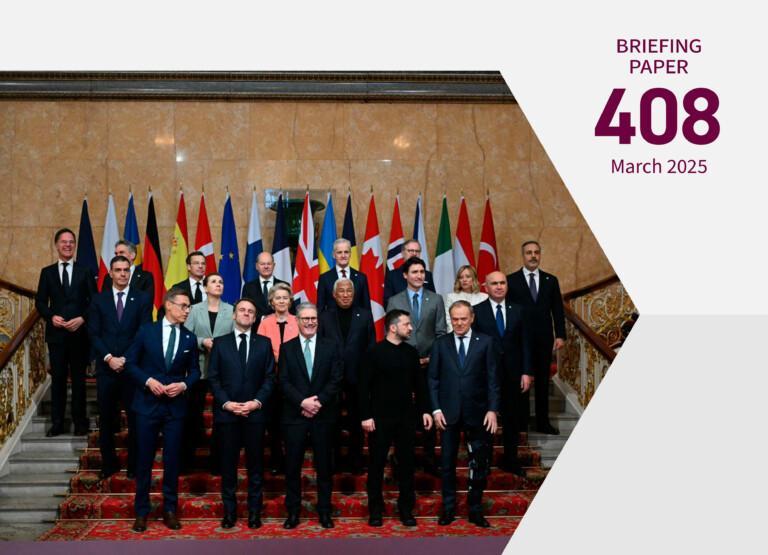
The EU’s Civilian CSDP Compact aims to revitalize an important tool that has been suffering from lack of interest among member states, amid the greater interest in boosting the EU’s defence capabilities instead.
Adding scalability and modularity to the Union’s civilian missions should make them more flexible.
Expanding the competences of internal security agencies to act externally may increase internal competition over the same resources and lead to overlapping tasks in external action.
Despite the momentum for reforming the EU’s key security instruments, there seems to be less interest in reforming the decision-making structures regarding them, which can lead to insufficient coordination and coherence between actors on the ground.
Introduction
Civilian crisis management in the EU has been suffering from a lack of member state interest in recent years. This has been reflected in difficulties in acquiring sufficient contributions from the member states, and a lack of political will to launch new missions. The 2016 EU Global Strategy for Foreign and Security Policy (EUGS) underlined the need to take decisive steps on Security and Defence and demanded more joined-up action because issues such as terrorism, violent extremism, migration, sustainable development, and cyber security are most effectively tackled together. Regarding the EU’s civilian crisis management, this has materialized in the Civilian Common Security and Defence Policy (CSDP) Compact.
According to the Compact, the new tasks of civilian crisis management are countering organized crime, terrorism and violent extremism, addressing irregular migration, supporting maritime security, and protecting cultural heritage. The missions execute their mandate mostly by mentoring and advising the local authorities and by transferring best practices from the EU countries. This means that the EU’s own security interests are more visible in the Compact, while local needs to strengthen the police, the rule of law and civil administration, known as the Feira principles, are less prominent than before. Furthermore, the Compact calls for more modular and scalable missions, which could more easily adapt to a changing situation in the target country and cooperate with other relevant international actors. In practice, the EU aims to cover a topic in crisis situations that is both relevant for the EU’s own interests, and not covered by any other international actor.
The EU’s civilian crisis management instrument needs to find its own niche not only among the other international actors in the crisis management framework, but also in relation to the rest of the European security apparatus. Its original focus, the Feira principles, is unique and valuable, but the EU’s civilian crisis management has nevertheless failed in getting the majority of member states to commit to its ethos, leading to downscaling in terms of both resources and new missions. This is its central problem. The EUGS and the general momentum for restructuring the EU’s internal and external security capacities and capabilities mean that there are other reforms and plans taking place in addition to the Civilian CSDP Compact. Although many of the reforms can complement each other, there is also increasing competition between the different instruments and agencies over the same resources.
Can the Compact succeed in raising interest in the civilian crisis management instrument among the member states? Are the changes relevant and major enough? Or can the other instruments supersede civilian crisis management with swifter decision-making, larger staff pools and more focused specialization, and could the possible repurposing of the civilian CSDP actually cut short its future? This Briefing Paper analyses and assesses the significance of the Compact in relation to the other reforms in the European security apparatus.
The Civilian CSDP Compact: from Feira to “principled pragmatism”
Civilian crisis management as an idea originates from the 1990s and has its roots in the global discussion sparked by the atrocities in Rwanda and Yugoslavia. In the Feira European Council in 2000, the EU stated strengthening the police, the rule of law and civil administration as its civilian crisis management priorities. Civilian crisis management rose to prominence during the Finnish presidency of the EU in 2006 with the adoption of the Action Plan for Non-Military Crisis Management. In contrast to purely “altruistic” development and humanitarian aid, crisis management is a political instrument. In the case of Finland, the political nature of crisis management is stated in the National Crisis Management Strategy.1
Civilian crisis management ideally works as a bridge in the security-development nexus, leaning towards one or the other based on the situation. In Niger, for example, the CSDP mission works to address particular security challenges as a part of the comprehensive EU Sahel strategy, which includes both security and development instruments.
Over the years, much of the enthusiasm that member states had for civilian crisis management has been lost. This has had an impact on the member state contributions and on the political will to use the instrument. Before EUAM Iraq, launched in October 2017, three years had passed without any new missions being launched, while EUPOL Afghanistan had shut down and EULEX Kosovo had been downscaled. At the same time, Frontex has increased its operations,2 which indicates that there has been a need for new operations, especially regarding the management of migration flows, which civilian crisis management could also be used for. Consequently, perhaps the biggest concern is that over 40% of the mission staff, not counting the locally recruited, are contracted directly by the missions, not seconded by the member states, and five of the largest seconding countries are responsible for over half of the overall secondments.3 This reveals a lack of commitment and ownership by the member states and erodes the principle of the CSDP being a member state-owned instrument.
Another concern has been the slow decision-making process in setting up a mission. Contemporary crises and conflicts do not allow for long bargaining processes between member states in the planning phase of a mission, as was observed in the case of EUBAM Libya, or for rigid mandates that hamper the effectiveness of missions in the event that the situation on the ground changes. Simultaneously, the military side of the CSDP has moved forward, gaining momentum with initiatives such as Permanent Structured Cooperation (PESCO) and the European Defence Fund. In addition, FSJ agencies such as Frontex and Europol have increased their competences in security policies, which makes them more tempting and effective tools for the EU in their own fields, when compared to civilian crisis management.
In 2016, the EU Global Strategy provided a blueprint for a “more capable, more responsible and more joined-up” EU, whose earlier idealism had turned into “principled pragmatism”.4 The Civilian CSDP Compact is a plan to operationalize this blueprint by updating and refocusing the civilian crisis management priorities and goals towards building sustainability and resilience, and by making the Union more responsive through developing its internal/external security nexus. In practice, the Compact does this by shifting the emphasis towards what the EU and the member states regard as important, in contrast to the emphasis that the Feira principles placed on the local perspective.
Practical changes
More capable and joined-up civilian crisis management primarily means modularity and scalability. These principles, which should be taken into account even at the planning phase, should allow civilian missions to be more adaptable to various changes. For example, as the conflict evolves, different capabilities might be needed from the mission, and it should be able to adapt accordingly.
The advisory mission EUBAM Libya, prior to its evacuation in July 2014, offers an example of the room for improvement that exists. EUBAM Libya was planned as a high-level strategic advisory mission to help establish a modern Integrated Border Management (IBM) system in Libya. However, political ambitions in mission planning trumped realism, and the mission was sent to carry out a task that was impossible in the collapsing country. After this became clear, the mission started pursuing secondary objectives, such as delivering basic training to the Libyan officials, effectively turning it into a training mission. However, it still had the staff of a high-level advisory mission, which hampered its effectiveness.
Modularity and scalability also connect to the broader idea of adaptive peacebuilding, which is a concept within the so-called pragmatic turn in international peacebuilding. Adaptive peacebuilding is an approach that emphasizes the need for peacebuilders to engage with the local people in an iterative process of learning the conflict and adapting to it, testing, abandoning and scaling up different approaches while attempting to resolve it.5
The Compact calls for increased contributions of personnel from the member states in order to respond to the challenges regarding recruitment and training. This primarily requires a commitment from the member states to encourage their agencies to send their personnel on CSDP missions. In many cases, the CSDP is not the first choice for a border management expert or a customs officer, especially if they are at a senior level, which has resulted in problems filling the senior positions of the missions with sufficiently experienced personnel.
Currently, the basic training prior to deployment is mostly carried out by the member states, but not all member states train their seconded personnel. At the same time, many member state institutions train a significant number of potential recruits who are never deployed, leading to a situation of vast overtraining in terms of volumes on the one hand, and missions where half of the members have never received basic training6 on the other. It is evident that this equation wastes resources and fails to deliver the required number of qualified experts. There is also a disconnect between the training provided and the mission needs, as in many cases the emphasis is more on creating a pool of recruits and less on the needs of the field. One of the practical outcomes of the Compact is to set up a new advisory body, the EU Civilian Training Group (EUCTG), to assess the real training needs and correct the above-mentioned distortions, among other things.
Developing the capability of the missions and member states still requires evaluation, best performed by an external and impartial agent. This is currently very rare, which hampers the effectiveness of the whole CSDP. The absence of proper evaluation also means that the mission planning process is not connected to the review and lessons learned systems. On the rare occasions that external evaluations have been carried out, like those conducted by the European Court for Auditors (ECA) for the missions in Mali and Niger, or the Horizon 2020-funded IECEU project, analyzing the effectiveness of numerous CSDP missions and operations, the benefits of external reviews have been evident. Substantially improving the review system will not be an easy task for Brussels institutions, as many members states are expected to oppose external evaluation of training provided, or staff seconded.
To speed up the planning and deployment of the missions, increasing qualified majority voting (QMV) in CSDP decision-making was a clear Commission target at the start of the Compact negotiations, but reaching this goal was not politically possible. However, this is something that needs to be further addressed in realizing the Compact, even though QMV might also reduce the commitment of member states to supporting the missions.
Other CSDP instruments in the EU
The EUGS underlined the need to strengthen EU policies and internal and external security actors. This has been echoed by most member states. For example, in his letter to Europe, French President Emmanuel Macron expressed the need for a European treaty on defence and security, setting up a new European security council.7 Many security challenges, such as terrorism and cyber threats, are most effectively tackled together as a union, not state by state. Thus, simultaneously with the Civilian CSDP Compact, many other security-related reforms and plans for reforms are taking place. Ideally, they would complement each other, but this is not necessarily the case.
Civilian crisis management has been an important tool for promoting state-building and good governance in many conflict zones. However, to be effective, civilian crisis management missions cannot act alone, but require the presence of other international organizations. The UN is often necessary for state consolidation in the case of a fractured state, providing room for the more precisely targeted EU civilian crisis management advisory and capacity-building activities. In addition, the same context often includes numerous private peace and mediation agents and development organizations. In more dangerous and risky crisis situations, there is a need for a military component as well. Since military crisis management can operate alone and is more easily deployed to various conflict zones during the armed phase of a conflict, there has been an in-built division and even competition between the military and civilian crisis management concepts.
Thus far, the military approach has predominated over the civilian approach. In 2018 the number of military staff in CSDP operations amounted to roughly 4,000, distributed across six different operations. At the same time, there were approximately 2,600 persons working in ten civilian missions.8 The update that the Compact provides can be seen as a move to present civilian crisis management more favourably in comparison to the military approach, as an instrument capable of producing concrete gains for common security, in the hope of a more balanced distribution of resources.
One of the most significant security-related processes of late is the Permanent Structured Cooperation on security and defence (PESCO), which aims to deepen European defence cooperation, capabilities and operational needs. PESCO is part of the Comprehensive Defence Package, which also includes the European Defence Fund (EDF). The EDF is subject to the Multiannual Financial Framework (MFF), which amounts to €13 billion for the period 2021—2027.9 Since the EU Treaty (Art. 41.2 TEU) does not allow for the Union’s budget to finance expenditure with military or defence implications, the EDF is earmarked for fostering cooperation on defence-related research and development, not for arming the EU. Until now, the EU’s military CSDP operations have been financed by the member states, and partially through the Athena mechanism. However, there is also a new instrument, the European Peace Facility, which is currently a €10.5 billion off-budget fund that tries to address the limitations of the EDF and Athena mechanism in order to improve the EU’s joined-up military efforts. Hence, there is a framework and a budget to improve the military capabilities of the EU. This is also beneficial from the point of view of civilian crisis management, since improving military structures and cooperation is directly linked to the civilian CSDP operations.
Aside from the military CSDP operations, the EU has battlegroups (EUBG), established in 2007 to improve the Union’s capability to rapidly respond to external threats. Battlegroups are 1,500-strong military units based on contributions from a coalition of member states. Two of them are poised for deployment at all times, and the responsibility to be on standby rotates regularly. Battlegroups could be used to support civilian crisis management operations, for example when establishing a new mission or in the case of an evacuation. A unanimous Council decision is required before the EUBGs can be deployed, but thus far they have not been tested in practice. Perhaps the biggest hurdle when it comes to using a battlegroup is its size, which limits the potential tasks that the instrument could fulfill.
From internal to external security
In addition to CSDP instruments, the EU has recently strengthened the Freedom, Security and Justice (FSJ) agencies, giving them competences to act outside of the EU as well. For example, negotiations have been conducted on enhanced cooperation and information sharing by Europol with North African and Middle Eastern countries, and the plans to enable Frontex to operate anywhere in the world (with the permission of the host country) with a 10,000-strong standing corps are underway. From the point of view of the new tasks of civilian crisis management operations designated by the Compact, this is a significant change in the EU’s external action. Regarding their decision-making structures, existing pools and resources, FSJ agencies are more effective and capable instruments than the civilian CSDP, which is more dependent on member state contributions.
Frontex may be the most significant FSJ agency that can overshadow the civilian CSDP, but it is not the only one. Europol has tried to extend its foothold, especially in North Africa regarding information sharing. The European Asylum Support Office (EASO) can support third countries in capacity-building and regional protection, and coordinate returns from the EU to countries of origin. Thus Frontex, Europol and EASO are embracing their fair share of neighbourhood policies and practices within their tasks to increase resilience and expand the EU’s border and migration management. Even if the tasks of crisis management and FSJ agencies differ, there is overlap in the external action.
More importantly, the Commission has repeatedly tried to centralize political control over the FSJ agencies, which would decrease the role of member states in the EU’s external operations. This would make the FSJ agencies a tempting choice in comparison to CSDP instruments, since they could have “boots on the ground” much more quickly and with fewer political compromises. So far, these proposals have been watered down by the member states. However, the mere capacity boost regarding the permanent staffing and equipment would tip the balance in favour of the agencies, since they would not be as dependent on complicated negotiations over member state contributions as the CSDP operations are.
Conclusion: Prospects for the civilian CSDP
It can be argued that a fair number of the reforms demanded in the Civilian CSDP Compact have already taken place, and the missions have undoubtedly changed in nature. Large and expensive missions, like EULEX Kosovo or the discontinued EUPOL Afghanistan, might have become outdated. Approaches that overextend themselves by trying to reform whole sectors of the state, as in Kosovo, or are too ambitious in transferring EU norms and culture to a society with different realities, as in Afghanistan, are not working. Current and new missions, like the ones in Niger or Somalia, have all been fairly small (fewer than 200 personnel) and the direction towards smaller, more strategic and more flexible civilian interventions is clear. Modularity and scalability prepare the instrument for wide cooperation with other international and local actors, such as the UN, AU and similar NGOs, but increasingly also with other EU instruments within the framework of the CSDP or internal security.
The idea of having “modular” civilian operations hints that CSDP operations could take on a coordinating role and source staff from FSJ agencies according to the needs of the situation. However, the agencies may also prefer clear lines between different actors and command structures, which would mean the EU dividing the operations between the CSDP and FSJ either geographically or sequentially. However, broadening the scope and sharing the responsibilities can erode the foundations of the civilian CSDP. These new tasks, such as migration management, counter-terrorism and preventing and countering extremism, are actually already the operational reality in many missions.
Bearing this in mind, the implementation process of the Compact is vital. The Compact calls for a leap in quality and quantity, for national implementation plans, and tangible and concrete results on how to improve EU civilian crisis management from the capabilities created by the member states to the planning and conduct in Brussels, and ultimately to the mission level. Rejuvenating the civilian CSDP is, however, not necessarily an easy task. Roughly half of the member states have not shown commitment, at least not if commitment is measured by the rate at which they send their personnel to the civilian CSDP missions – which doesn’t come close to the more active seconding countries. Whether this can be changed and the civilian CSDP developed into an instrument for the whole, or even the majority, of the EU will be the ultimate test determining the success or failure of the Compact.
In discussing the shift from the Feira principles to “principled pragmatism”, the biggest thematic concern has been the possible repurposing of the civilian CSDP towards irregular migration control. It is commonplace and tempting to argue that by building the capacities of border management and the security sector one could reduce the subsequent internal security problems in the Union that are caused by irregular migration. This is an argument that can motivate member state capitals to contribute more to civilian crisis management.
The evident risk in this shift of emphasis from local priorities towards donor needs is, of course, erosion of the fundamentals of the civilian CSDP that used to build on local needs. In the case of EUCAP Sahel Niger, the EU arguably prioritizes border control and migration management instead of the local needs of stabilization and development,10 and in the case of Libya, the EU has remained committed to strengthening border management, notwithstanding the difficulties the mission has faced. The root causes of conflicts and forced displacement in Africa are poverty, climate change and high birth rates, but EU civilian crisis management is now mostly concerned with treating only the symptoms.
The question is, how do the member states see the utility of civilian CSDP operations in relation to the other instruments and agencies in the EU? Since there is some overlap in the tasks, expanding the competences of FSJ agencies to act outside of the EU means that there is also a risk of competition between the EU instruments over the same resources, from finances to equipment and human resources. As many of the reforms are currently in progress and it is unclear how they will play out in practice, it is still difficult to estimate their overall impact on the general dynamics regarding the CSDP. In any case, there needs to be a clear strategic vision of what the internal/external security nexus will look like, and proper, coordinated and coherent leadership when it comes to determining how to get there. That said, simultaneously reforming several security instruments before the previous reforms have been fully implemented does not reflect such a strategic vision.
References
1 Siviilikriisinhallinnan kansallinen strategia, Valtioneuvoston kanslian julkaisusarja 8/2014, p. 10.
2 COM(2018) 631 final, p. 5.
3 Personnel Figures for Civilian CSDP Missions as of 28.2.2019. EEAS.
4 https://europa.eu/globalstrategy/sites/globalstrategy/files/regions/files/eugs_review_web_0.pdf.
5 Cedric de Coning, “Adaptive peacebuilding”, International Affairs 94:2, March 2018, pp. 301–317, https://doi.org/10.1093/ia/iix251.
6 Questionnaire on CSDP-related training opportunities for CSDP Missions, EEAS/CPCC/FN/J1//(2015)5501818.
7 https://www.theguardian.com/commentisfree/2019/mar/04/europe-brexit-uk?CMP=share_btn_tw
8 https://eeas.europa.eu/sites/eeas/files/e_csdp_annual_report1.pdf.
9 http://europa.eu/rapid/press-release_IP-18-4121_en.htm.
10 https://www.iai.it/en/pubblicazioni/civilian-csdp-compact-strengthening-or-repurposing-eu-civilian-crisis-management.









